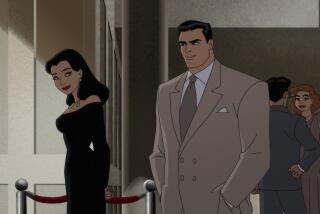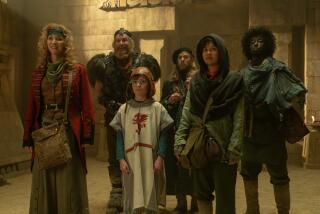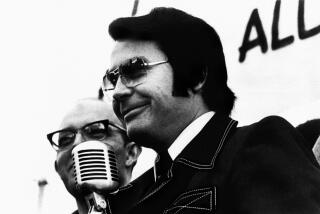TERRY JONES : On a New Crusade
- Share via
What better tour guide to take viewers through the Middle Ages than an alumnus of the Monty Python troupe?
Terry Jones leads a fascinating, fast-paced look at 200 years of religious conflict in the new A&E; and History Channel series “Crusades.” The irreverent and knowledgeable Jones attempts to shed light on the wars that began in the 11th Century and pitted Christendom against Islam. Jones, often decked out in period dress, retraces the journey of the Crusaders--through Northern Europe, Turkey, the Middle East and Italy--and encounters Christians and Muslims who talk about their religious culture today.
The four-part documentary also utilizes virtual-reality graphics and body-painted actors who bring frescoes, illuminated manuscripts and mosaics to life. Jones and series’ producer-director Alan Ereira also have written a companion book that stayed on the British bestseller lists for several months last year.
Best known as a member of the enormously popular Monty Python comedy group, the 52-year-old Jones has directed such films as “Life of Brian” and “Personal Services” and has written several books, including “Chaucer’s Knight” and “The Curse of the Vampire’s Socks and Other Doggerel.”
Times Staff Writer (and longtime Monty Python) fan Susan King discussed “Crusades” with Jones over the phone while he was vacationing in his native Wales.
So, did you develop a passion for the Crusades after doing “Monty Python and the Holy Grail”?
I didn’t really have a passion at all. The BBC approached me and asked if I’d like to do a series about the Crusades. I wrote a book around 1980 about Chaucer called “Chaucer’s Knight,” which was sort of an academic book taking the knight in “The Canterbury Tales” and trying to sort of see the reality beyond the description. It was a kind of a historical reconstruction to answer a literary problem. The BBC had been trying to get me to do a historical program for quite awhile. Alan Ereira approached me with this idea about the Crusades.
I think there are two things which really made me decide to do it. One was that Stephen Runciman’s three-volume history of the Crusades has been sitting on my shelves since I left Oxford in 1965. I’ve only read about 20 pages which were relevant to “Chaucer’s Knight.” I thought if I don’t do the series I will never read those three books. So I can tell you they were in pristine condition and now they are all tattered and the spines are all falling off. The other reason I wanted to do it was Alan had said that what he wanted to do was not just present [the Crusades] from the Christian point of view, but also from the Islamic, from the Muslim point of view. I thought that was really interesting. So, in fact, what happens is the first two shows are more or less from the Christian point of view, but as soon as Jerusalem is conquered, we sort of switch to the Islamic response to it. I find that the most interesting.
*
Why is it the most interesting to you?
It’s all fascinating, riveting stuff, but it was material that I was absolutely unfamiliar with. Also, the Arab heroes like Nurreddin and Saladin are great characters. Nurreddin was one of the first men to realize the use of propaganda on a big scale.
I think one of the most mind-boggling things is the Christian ignorance of Islam at the time and even now. The Muslims were more aware of the Christians. From the Muslim point of view, they were people in a shared religious environment. The Christians had no concept that Islam was even a related religion. When I started doing the Crusades stuff a couple of years ago, it was actually an eye-opener to realize that the Koran was retelling stories from the Bible. I though it was some totally different thing.
*
The fourth Crusade amazingly enough was a commercial enterprise that went bankrupt. Can you talk about that?
Basically what happened is that you had a lot of French aristocrats who decided to get another Crusade going. They commissioned agents to go and negotiate with the people in Venice to actually supply them with ships and everything to organize it. They said we will probably have, like, 60,000 Crusaders, and give us a price, so the Venetians gave them a price for so much a head. Then, about a year later, they started collecting in Venice and they discovered they overestimated. They had about 11,000 Crusaders, but the Venetians had made all the ships and said, “You still have to pay the money.”
So the Venetians had them over the barrel. The Venetians said, “Tell you what. We will postpone what you owe us if you come and help us recapture the town of Zara,” which was in Hungary. So the Crusaders agreed to go and recapture the town and then go on to the Holy Land. But the only trouble was the king of Hungary was not only Christian, he was a fellow Crusader. So they were going off to capture the city from a fellow Crusader. After that, they still didn’t have enough money, so the Venetians then said they should go to Constantinople and do a bit of business there. In the end they sacked Constantinople, which was a Christian city.
*
The series was filmed on location. That must have been fascinating to see where these events actually happened.
It was really fantastic. Syria is amazing actually. We had about two months. ... we did it in two bites really. You could do Turkey and Israel, but then you couldn’t go to Syria because if you had an Israeli stamp on your passport they wouldn’t let you in. So we had to do it in two parts.
*
I’m dying to know what it was like to wear the chain-mail attire.
The chain mail didn’t fit me (laughs). It was supposed to be made to measure and it didn’t. It was far too tight on me. Chain mail isn’t all that bad to wear, but if it’s too tight, it’s awful.
“Crusades” airs Monday-Thursday at 6 and 10 p.m. on A&E; and the History Channel.
More to Read
Sign up for The Wild
We’ll help you find the best places to hike, bike and run, as well as the perfect silent spots for meditation and yoga.
You may occasionally receive promotional content from the Los Angeles Times.







